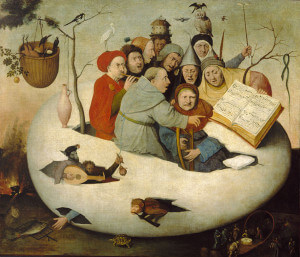Consort of the egg
T he Consort of the Egg
he Consort of the Egg
Popular and academic music in XVI century Europe
Songs, villanellas, madrigals and motets from the Middle Ages to the XVII century. From a painting by Hieronimus Bosch the idea of reviving the spirit and adventure of European Renaissance polyphony.
The “Concert in the Egg” by Hieronimus Bosch (currently displayed in the Lille Museum in France) is the key to understanding the spirit of the world emerging from the Middle Ages and projected into the future, which we are now living. From this painting by Hieronmus Bosch comes the idea of reviving the spirit and adventure of ancient polyphony from its origins to its most mature fruits in the XVII century. The visionary poetry radiating from that sort of egg-shaped spaceship suggests the interpretations of the programme of vocal polyphony presented by the Troubar Clair ensemble.
In this extraordinary painting by the Flemish artist, a crew on board a huge egg is flying over the evils of the world, totally absorbed in deciphering a musical code that seems to be replacing the instrument board in the cockpit. The propellant of this egg-shaped rocket is nothing but the music that these nine Argonauts are reading from their big book. Music is the means of travelling the world, exploring it and finding out where it is going.
Renaissance music has come down to us perfectly encoded in printed books of superb craftsmanship, which enabled the transcription and interpretation of the musical notations left to us by the great composers of that time.
The XVII century managed to give a revolutionary answer to the widespread need of a new way of thinking to face approaching Modernity. Renaissance music is evidence of that revolution in the same way as Bosch’s images manage to explain the crisis of western culture with striking immediacy.
Programme
- La Bataille de Marignan – Clément Janequin (c. 1485 – 1558)
- Tourdion – Pierre Attaingnant (c. 1494 – 1551)
- Gloria ad modum tube – Guillaume Dufay (c. 1397 -1474)
- Veni creator spiritus – Anonimo (XIV sec.)
- Angelorum glorie – Anonimo (XIII sec.)
- Mille regrets – Josquin Des Prez (c. 1450 – 1521)
- Ah quando haveva una vicina – Adrian Willaert (c.1490 – 1562)
- Il bianco e dolce cigno – Jacques Arcadelt (1504 – 1568)
- Madonna mia pietà – Orlando di Lasso (1530 – 1594)
- Madonna quanto piu stratij – Giovanni Nasco (c. 1510 -1561)
- Finestra bella – Giovanni Nasco (c. 1510 -1561)
- Come again – John Dowland (c. 1562 – 1626)
- Sfogava con le stele – Claudio Monteverdi (1567 – 1643)
- Plorate filii israel – Giacomo Carissimi (1605 – 1674)
- Todos los bienes del mundo – Juan del Encina (1468 – 1529)
- So ben mi ch’a bon tempo – Orazio Vecchi (1550 – 1605)